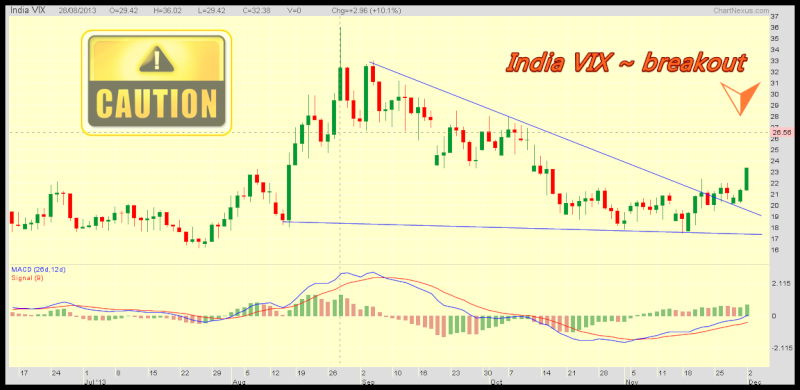__________________________________________________ ______
About India VIX*
Thumb Rule
India VIX and Market Movement go opposite to each other.
1. When Volatility increases i.e. India VIX is HIGH, Market goes DOWN.
2. When Volatility decreases i.e. India VIX is LOW, Market goes UP.
________________________________________________________
About India VIX*
India VIX is a volatility index based on the index option prices of NIFTY. India VIX is computed using the best bid and ask quotes of the out-of-the-money near and mid-month
NIFTY option contracts which are traded on the F&O segment of NSE. India VIX indicates the investor’s perception of the market’s volatility in the near term. The index depicts the expected market volatility over the next 30 calendar days. i.e. higher the India VIX values, higher the expected volatility and vice-versa.
India VIX computation methodology
India VIX uses the computation methodology of CBOE, with suitable amendments to adapt to the NIFTY options order book using cubic splines, etc.
The factors considered in the computation of India VIX are mentioned below:
1) Time to expiry:
The time to expiry is computed in minutes instead of days in order to arrive at a level of precision expected by professional traders.
2) Interest Rate:
The relevant tenure NSE MIBOR rate (i.e. 30 days or 90 days) is being considered as risk-free interest rate for the respective expiry months of the NIFTY option contracts
3) The forward index level:
India VIX is computed using out-of-the-money option contracts. Out-of-the-money option contracts are identified using forward index level. The forward index level helps in determining the at-the-money (ATM) strike which in turn helps in selecting the option contracts which shall be used for computing India VIX. The forward index level is taken as the latest available price of NIFTY future contract for the respective expiry month.
*“VIX” is a trademark of Chicago Board Options Exchange, Incorporated (“CBOE”) and Standard & Poor’s has granted a license to NSE, with permission from CBOE, to use such mark in the name of the India VIX and for purposes relating to the India VIX.
4) Bid-Ask Quotes
The strike price of NIFTY option contract available just below the forward index level is taken as the ATM strike. NIFTY option Call contracts with strike price above the ATM strike and NIFTY option Put contracts with strike price below the ATM strike are identified as out-of-the-money options and best bid and ask quotes of such option contracts are used for computation of India VIX. In respect of strikes for which appropriate quotes are not available, values are arrived through interpolation using a statistical method namely “Natural Cubic Spline”
After identification of the quotes, the variance (volatility squared) is computed separately for near and mid month expiry. The variance is computed by providing weightages to each of the NIFTY option contracts identified for the computation, as per the CBOE method. The weightage of a single option contract is directly proportional to the average of best bid-ask quotes of the option contract and inversely proportional to the option contract’s strike price.
Computation of India VIX
The variance for the near and mid month expiry computed separately are interpolated to get a single variance value with a constant maturity of 30 days to expiration. The square root of the computed variance value is multiplied by 100 to arrive at the India VIX value. For further details please refer to the white paper with the detailed methodology on computation of India VIX at
www.nseindia.com
Thanks to : Vilas Havanur























